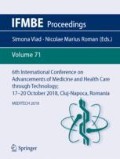Abstract
Hepatocellular carcinoma (HCC) represents the most frequent form of liver cancer. It evolves from cirrhosis, as the result of a restructuring phase at the end of which dysplastic nodules appear. HCC is the main cause of death in people affected by cirrhosis. The most reliable method for HCC diagnosis, the golden standard, is the needle biopsy, but this is an invasive technique, dangerous for the human body. We develop computerized methods, based on ultrasound images, in order to perform automatic diagnosis of HCC in a noninvasive manner. In our previous research, we elaborated the textural model of HCC, based on classical and advanced texture analysis methods, in combination with traditional classification techniques, which led to a satisfying accuracy. We aim to improve this performance in our current and further research. In this article, we analyzed the role of specific deep learning techniques concerning the automatic recognition of HCC from ultrasound images. We chose the Convolutional Neural Networks (CNN), this method being well known for its performance in the field of image recognition. Thus, CNN are based on artificial neural networks, they also performing image processing operations, such as inner convolutions. In order to evaluate the newly adopted technique, we assessed the classification accuracy achieved in the cases of distinguishing HCC from the cirrhotic parenchyma on which it had evolved, respectively when differentiating HCC from the hemangioma benign liver tumor. We compared the accuracy of CNN with our previous results, based on texture analysis methods and it resulted that CNN yielded better recognition rates than the classical texture analysis techniques, respectively comparable with those provided by the advanced texture analysis methods. However, further improvements will be necessary, which we mention within the last section of this article.
Access this chapter
Tax calculation will be finalised at checkout
Purchases are for personal use only
References
Sherman, M.: Approaches to the diagnosis of hepatocellular carcinoma. Curr. Gastroenterol. Rep. 7(1), 11–18 (2005)
Yoshida, H., Casalino, D.: Wavelet packet based texture analysis for differentiation between benign and malignant liver tumors in ultrasound images. Phys. Med. Biol. 48, 3735–3753 (2003)
Madabhushi, A., et al.: Automated detection of prostatic adenocarcinoma from high-resolution ex vivo MRI. IEEE Trans. Med. Imaging 24(12), 1611–1626 (2005)
Chikui, T., et al.: Sonographic texture characterization of salivary gland tumors. Ultrasound Med. Biol. 31(10), 1297–1304 (2005)
Ker, J., Wang, L., et al.: Deep learning applications in medical image analysis. IEEE Access 6, 9375–9389 (2018)
Jiang, J., et al.: Medical image analysis with artificial neural networks. Comput. Med. Imaging Graph. 34(8), 617–631 (2010)
Li, W., Jia, F., Hu, Q.: Automatic segmentation of liver tumor in CT images with deep convolutional neural networks. Comput. Commun. 3, 146–151 (2015). https://doi.org/10.4236/jcc.2015.311023
Vivanti, R., Ephrat, A., et al.: Automatic liver tumor segmentation in follow-up CT studies using convolutional neural networks. In: Patch-Based Methods in Medical Image Processing Workshop, pp. 54–61 (2015)
Li, W., Cao, P., et al.: Pulmonary nodule classification with deep convolutional neural networks on computed tomography images. Comput. Math. Methods Med. 7 pages (2016). https://www.hindawi.com/journals/cmmm/2016/6215085/
Mitrea, D., Mitrea, P., Nedevschi, S., Badea, R., et al.: Abdominal tumor characterization and recognition using superior order co-occurrence matrices, based on ultrasound images. Comput. Math Methods Med. 17 pages (2012)
Materka, A., Strzelecki, M.: Texture Analysis Methods—A Review. COST B11 Report (1998). http://citeseer.ist.psu.edu/viewdoc/summary?doi=10.1.1.97.4968
Mitrea, D., Nedevschi, S., Badea, R.: Automatic recognition of the hepatocellular carcinoma from ultrasound images using complex textural microstructure co-occurrence matrices (CTMCM). In: Proceedings of the 7th International Conference on Pattern Recognition Applications and Methods (ICPRAM), Jan 2018, pp. 178–189 (2018)
Deep Learning Tutorial, Release 0.1, LISA lab, University of Montreal, Copyright Theano Development Team (2015)
Tajbakhsh, N., et al.: Convolutional neural networks for medical image analysis: full training or fine tuning? IEEE Trans. Med. Imaging 35(5), 299–1312 (2016). https://doi.org/10.1109/tmi.2016.2535302
Yasaka, K., Akai, H., et al.: Liver fibrosis: deep convolutional neural network for staging by using gadoxetic acid-enhanced hepatobiliary phase MR images. Radiology 287(1), 146–155 (2018)
Byra, M., Styczynski, G., et al.: Transfer learning with deep convolutional neural network for liver steatosis assessment in ultrasound images. Int. J. Comput. Assist. Radiol. Surg. 13(12), 1895–1903 (2018)
Litjens, G., Kooi, T., et al.: A survey on deep learning in medical image analysis. Med. Image Anal. 42, 60–88 (2017)
Weka 3 (2018). http://www.cs.waikato.ac.nz/ml/weka/
Neural Network Toolbox for Matlab (2018). https://www.mathworks.com/products/neural-network.html
Acknowledgements
This work was founded by the Romanian National Authority for Scientific Research and Innovation under Grant number PN-III-P1-1.2-PCCDI2017-0221 Nr. 59/1st March 2018.
Conflict of Interest
The authors declare that they have no conflict of interest.
Author information
Authors and Affiliations
Corresponding author
Editor information
Editors and Affiliations
Rights and permissions
Copyright information
© 2019 Springer Nature Singapore Pte Ltd.
About this paper
Cite this paper
Mitrea, D., Brehar, R., Mitrea, P., Nedevschi, S., Platon(Lupşor), M., Badea, R. (2019). The Role of Convolutional Neural Networks in the Automatic Recognition of the Hepatocellular Carcinoma, Based on Ultrasound Images. In: Vlad, S., Roman, N. (eds) 6th International Conference on Advancements of Medicine and Health Care through Technology; 17–20 October 2018, Cluj-Napoca, Romania. IFMBE Proceedings, vol 71. Springer, Singapore. https://doi.org/10.1007/978-981-13-6207-1_27
Download citation
DOI: https://doi.org/10.1007/978-981-13-6207-1_27
Published:
Publisher Name: Springer, Singapore
Print ISBN: 978-981-13-6206-4
Online ISBN: 978-981-13-6207-1
eBook Packages: EngineeringEngineering (R0)

